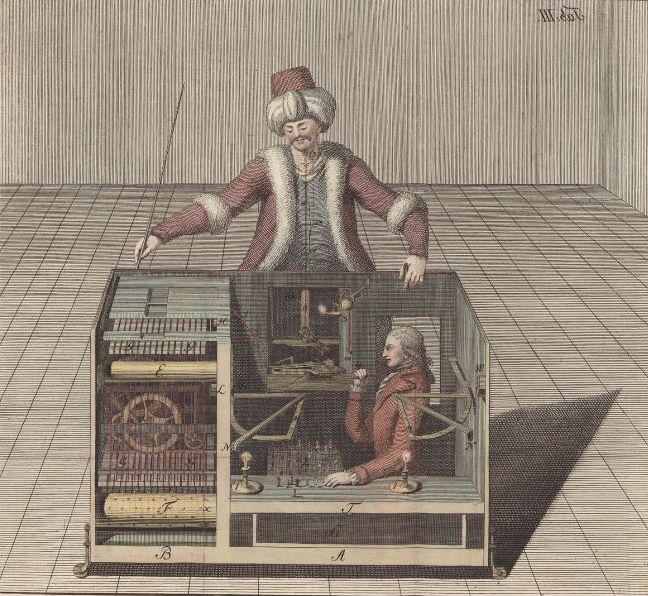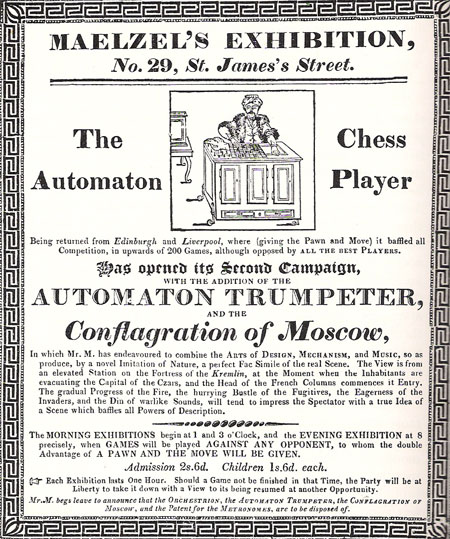The Mechanical Turk was a chess-playing machine built in 1770. It was displayed as a chess-playing robotic mechanical wonder, when in fact it was a very clever hoax - it was designed to conceal a human chess player, who operated the "robotic" chess player via magnets and levers. With the top and front removed, it looked something like this:
(The Turk is the larger chess-playing wooden figure, and the actual human chess player is the smaller one concealed inside the box).
The Mechanical Turk was created by Hungarian inventor and engineer Wolfgang von Kempelen.
Prior to a game of chess, Kempelen would open the cabinet doors of the machine, "proving" that there was nothing inside but various mechanical workings. At the time, the development of science was such that the Turk was considered by most not to be magical, but more likely a very complex machine. In fact, the Turk concealed a hidden human chess player who was actually positioned on a sliding seat, and would move from side to side inside the Turk cabinet as Kempelen made his pre-game display.
The Turk became more and more famous, but Kempelen wasn't particularly happy about it, instead preferring to work on steam engines and his human speech replication machine. He dismantled the Turk, but was ordered by the King of Germany to reconstruct it for a performance with the Grand Duke of Russia, in 1781. This display was so successful that the Grand Duke convinced Kempelen to tour Europe with the Turk. It was on this European tour, in Paris, that the Turk played and defeated none other than Benjamin Franklin, who was serving as the US ambassador to France.
Kempelen then displayed the Turk in London, again toured Europe with it, and then it appears to have stayed at Schonbrunn Palace in Vienna. In 1804, Kempelen died, and his son sold the Turk to a Bavarian musician named Johann Nepomuk Mälzel. Mälzel learned the Turk's secrets, did some repairs, and put it back in action. In 1809, Napoleon Bonaparte came to Schonbrunn Palace to play the Turk, and the Turk won. Rumor has it that Napoleon tried to cheat, but the Turk became "angry" and swept the pieces off the board.
Then Mälzel took the Turk to Milan, Paris, and around the UK. In 1826, Mälzel took the Turk on an American tour, where at one point it was even the subject of an 1836 essay by Edgar Allen Poe.
Many people tried to "debunk" the Turk, but although they were correct in that it wasn't actual artificial intelligence, they thought that a human player was concealed inside the Turk doll (instead of in the cabinet), or that a small child or a trained monkey was hidden inside the workings.
Mälzel died at sea in 1838, and the Turk changed hands again, first to the captain of the ship, then to a friend, then finally to John Kearsley Mitchell, a Turk admirer who was also the personal physician of Edgar Allen Poe. Mitchell restored the Turk in 1840, then eventually donated it to a museum, where it was destroyed by a fire in 1854.
In 1984, John Gaughan, an American manufacturer of magician's equipment, started building his own version of the Turk. 214 years after the first Turk was built, Gaughan displayed his reproduction at a history of magic conference in 1989.
The concept of the Mechanical Turk lives on today in various references in science and literature. Most importantly, it exemplifies a critical analogy of the human experience: hidden inside our most amazing technology is a simple, ordinary human being.


 LinkBack URL
LinkBack URL About LinkBacks
About LinkBacks







 Reply With Quote
Reply With Quote



Bookmarks